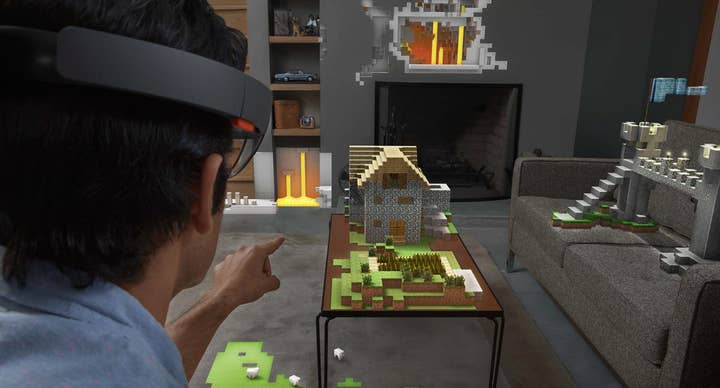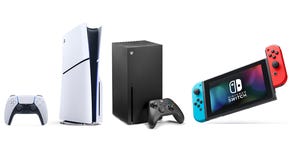HoloLens: Can it live up to Microsoft's sizzle video?
An ambitious, creative effort to redefine how we interact with technology; 2015 is looking more and more like a watershed year
Sometimes I feel like we take the pace of technological progress rather for granted. My instant reaction to the unveiling of Microsoft's ultra-futuristic, science-fiction-esque augmented reality technology, HoloLens, was to think how great it is that so many major technology companies seem to be focused, this year, on big new ideas; wearable computers, VR headsets, augmented reality displays; all ideas that could fundamentally change how we interact with technology, information and entertainment. "Finally!", I thought, as if this indicated that we are emerging from some long creative drought, countless parched years of dull evolution with no sign of revolution worth mentioning.
I wasn't alone in that reaction; indeed, it's an undertone of a great deal of media coverage and private conversation about the aforementioned technologies. It is, of course, a terribly unfair reaction. Sure, a great many things in our lives evolve rather than changing dramatically; I'm typing this on a powerful, wafer-thin, ultra-light laptop that runs for a full working day without needing to recharge, which is all fantastic but still, ultimately, a laptop computer which is similar in concept and function to laptop computers I owned in the 1990s. Other things truly have changed our lives, though; tablets, which only became popular (and useful for the mass market) with the iPad back in 2010, are ubiquitous now, but modern smartphones, introduced in 2007, have truly changed the world and our lives - mostly, I'd argue, for the better. 2007 is not all that long ago; I guess we've come to expect world-altering technological leaps on a pretty aggressive schedule.
"Ultimately, though, an expensive device you need to strap to your head seems to have real value to core gamers only if it maximises immersion in the game world, which is precisely the opposite of what HoloLens aims to achieve"
Still, there is something really exciting about seeing the world's tech companies really throwing their weight behind ideas that are different, innovative and hold the potential to be the next big, world-changing thing. Google and Apple believe in wearable tech and will push it hard in 2015. Sony and Facebook have placed big bets on virtual reality; there's a reasonable chance that one of them, at least, will have a product on sale to consumers within the next 12 months. Now Microsoft has picked up the augmented reality concept and seems set to pursue it aggressively, albeit probably not in consumer form for quite some time. Google, of course, has placed bets in this area as well, with Google Glass; part of what makes Microsoft's HoloLens offering so immediately interesting is that it's such a different approach to Glass, treating the tech as something you slip on to perform specific tasks in your home or work environment, rather than something you wear all the time, including out in public - with all the attendant privacy-related creepiness that brings.
From the perspective of videogames, each of these technologies has exciting potential. Virtual reality headsets have focused on games as their killer application from the outset; early adopters of the tech are most likely to be core gamers. Wearable devices are at the other end of the spectrum, with gaming applications undoubtedly possible but a little tricky to conceptualise - though someone, somewhere out there, probably has an amazing Apple Watch or Google Gear game in mind already - and early adopters are more likely to be interested in either the technical or fashion aspects of the devices than in gaming per se. HoloLens falls somewhere in the middle of this spectrum. Microsoft made much of the gaming potential of the technology - and started eking value from its acquisition of Minecraft developer Mojang with a by-all-accounts impressive tech demo of Minecraft running as augmented reality overlaid over a real-life space. Ultimately, though, an expensive device you need to strap to your head seems to have real value to core gamers only if it maximises immersion in the game world, which is precisely the opposite of what HoloLens aims to achieve. In itself, that's an interesting idea, but it presents major challenges to game designers and will most likely see early adoption focused away from gamers and towards different classes of user.

The interesting thing about all this new technology, though, is that even if none of it turns out to be a world-shaking upheaval in the way that smartphones were, each class of device looks set, at least, to enjoy a healthy niche. Virtual reality will work very well for certain types of game, and the "you look goofy" crowd clearly haven't considered how many play-hours of Destiny are carried out by people sitting alone and in various states of undress (and that's just in my own living room); for games primarily played physically alone (albeit interacting with others online), the "goofy headset" aspect simply doesn't matter. Smart-watches, meanwhile, already have some adherents despite the well-discussed interface issues of Google Gear; with Apple entering the market this year (though I suspect their pricing will be more like a watch than a gadget, which is to say, bloody expensive) and other manufacturers upping their game in response, this field certainly feels like the one with the most likelihood to rival the ubiquity of smartphones, a few generations of hardware and software down the line. Then there's augmented reality; a word which Microsoft largely seemed to avoid, incidentally, preferring the term "hologram" - perhaps a deliberate attempt to distance themselves from Google Glass. I'm not sure I see very many people donning a bulky headset in their kitchen in order to read virtual notes on the fridge, but the potential for collaborative working or playing in shared virtual spaces seems enormous; rather than being a direct rival to VR, HoloLens and products like it could be VR's more sociable cousin.
"my concern is that it's going to be way less impressive in a room that doesn't look like an expansive, rather clinically tidy Ikea showroom"
The elephant in the room, of course, is the question of how well any of this actually works - especially HoloLens, the latest addition to the pantheon and the one of most questionable lineage. Bluntly, I don't trust Microsoft's so-called "sizzle" videos - stylish packages put together to introduce audiences to the potential of new technologies - any further than I could throw the aforementioned elephant, and I'm really not certain just how well HoloLens is going to be able to render an elephant in a room. Part of the cynicism which colours my otherwise enthusiastic response to the product relates to the fact that much of it is clearly a development of technology first seen in Kinect; all that stuff related to mapping real-world spaces so that software can make sense of them is more or less what Kinect was purported to do. Problem is, Kinect also had very impressive "sizzle" videos which basically turned out to be wildly over-optimistic at best, or a pack of lies at worst; the technology never worked reliably and enjoyably in the way it was originally presented, which is a big part of the reason why it became such a millstone around the neck of the Xbox One.
I don't doubt that the Kinect-related elements have been much improved (honestly, the Xbox One version of the tech never really got a fair shake, with customer reaction to it being coloured largely by bad experiences of the original peripheral) but the claims being made for HoloLens in Microsoft's promotional material simply feel suspect - partially due to track record and partially due to a raised eyebrow at the enormous leap being proposed here over existing, largely unimpressive, implementations of augmented reality. I don't doubt that HoloLens can do impressive things in ideal conditions; as with Kinect, my concern is that it's going to be way less impressive in a room that doesn't look like an expansive, rather clinically tidy Ikea showroom. Even so, if the first version of the technology does even half of what the sizzle video claimed, it will be amazing; it's just that it'll forever be condemned to comparison with that video, with nobody at Microsoft having ever heard the adage about under-promising and over-delivering, it seems.
So, pinches of salt all round. 2015 is going to be an amazing year for personal technology, with wearables going mass-market (probably), VR finally reaching consumers (possibly) and interest building around a whole new category of "holographic" augmented reality (albeit with a consumer launch likely quite far off). Each of these developments will bring new opportunities for game designers and creators; new ways to entertain and interact. Each of them, too, definitely needs that pinch of salt. There are lots of problems to be ironed out, from pricing and business model to basic functionality or technological polish; a year with so many ambitious "version 1" products turning up is also a year that's going to have its fair share of disappointments. Still; I'll take being underwhelmed by ambitious moonshots over being underwhelmed by slightly faster laptop processors and slightly higher resolution screens any time - and I can't wait to see the new ways that like-minded game designers find to entertain and entrance with these new categories of hardware.









